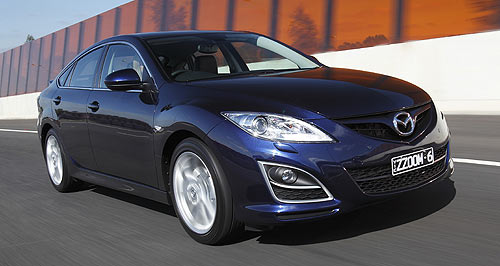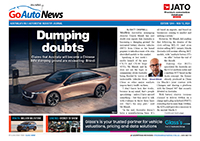Make / Model Search
Future models - Mazda - Mazda6Sydney show: Next Mazda6 to return 4.2L/100kmSky light: The next Mazda6 will have ultra-efficient Sky engines and will be based on an all-new platform that is at least 100kg lighter than the existing one. Mazda stages Oz debut of Sky powertrains that will return 4.2L/100km in next Six15 Oct 2010 NOT content with staging the world debut of its next-generation BT-50 one-tonner in Sydney today, Mazda also announced that a “future mid-sized model” will return average fuel consumption of just 4.2L/100km and CO2 emissions of only 112g/km. Mazda also revealed a new global sales target of 1.7 million annual sales by 2016, an increase of 500,000 units over last year. The commitments were made by Mazda Motor Corporation chairman, president and CEO Takashi Yamanouchi, who unveiled the all-new BT-50 during this morning’s Australian International Motor Show opening.  From top: Mazda Sky-D engine, Mazda Sky-G engine, Mazda Sky transmission, Mazda Shinari concept. From top: Mazda Sky-D engine, Mazda Sky-G engine, Mazda Sky transmission, Mazda Shinari concept.While he stopped short of confirming the identity of the super-frugal new mid-sizer – which will be far more economical than Toyota’s Camry Hybrid (6.0L/100km) and almost as efficient as the small Prius hybrid (3.9L/100km) – Mazda’s global chief also announced that its ground-breaking new Sky-D turbo-diesel engine and Sky-Drive six-speed automatic transmission will debut in Australia in 2012. Mr Yamanouchi added that, before then, the all-new Sky-G petrol engine will debut in Australia with Mazda’s new fuel-saving idle-stop technology in 2011. Although Mazda is yet to confirm which models its new Sky powertrain technologies will debut in, GoAuto believes a facelifted Mazda3 with a 2.0-litre Sky-G petrol engine is likely to go on sale in Australia by late 2011 – the same year idle-stop technology could be applied to the Mazda2. Then, by late 2012, we expect a redesigned Mazda6 to be released in Australia with a 2.2-litre Sky-D diesel engine and six-speed Sky-Drive automatic transmission. Apart from being the first Mazda model to wear the Japanese’s brand’s new Kodo design language – as previewed last month by the Shinari concept car – the next Mazda6 will be based on an all-new sixth-generation platform that is at least 100kg lighter. We drove a prototype of the next Mazda6 in Germany in August, in which the twin-turbo Sky-D diesel engine delivers only marginally more power (136kW) but considerably more torque at 420Nm, from just 2000rpm. As we reported then, combined with lower weight and improved aerodynamics, both manual and automatic versions of the Mazda6 ‘mule’ were also much more efficient (4.2L/100km and 105g/km) than the current manual-only Mazda6, which returns 5.9L/100km as a hatch and 6.0L/100km as a wagon. “If we put the new-generation Sky-D diesel engine in a Mazda6-size vehicle, efficiency will be the same as the Mazda2 – a vehicle that is two sizes smaller,” said Mr Yamanouchi yesterday. “Although you’ll have to wait until 2012, we have already verified those numbers. The new diesel engine will not only offer lower consumption and emissions, it will be built at lower cost.” Mazda has committed to reducing the fuel consumption of its new vehicle fleet by 30 per cent between 2008 and 2015, by fitting Sky powertrains and reducing the weight of its future models. While the larger but lighter new diesel-powered BT-50 is expected to be more economical, it will not come with Sky engine technology and is unlikely to be 30 per cent more fuel-efficient than the current model. However, Mr Yamanouchi said the fitment of more extensive fuel-saving technologies in other models will make up for its shortfall. “In terms of the (BT-50) powertrain, it is not included in the (Sky) program yet, but the weight reduction elements are in there. It will contribute to our achievement of a 30 per cent efficiency reduction on a global basis. “Some products will get all those (fuel-saving) measures and other others won’t, but on average the reduction will be 30 per cent. “For example, if we incorporate every technology into Mazda2, we could achieve a 40 per cent reduction in fuel economy.” As we reported in August, Mazda Australia plans to capitalise on the release of the new BT-50 in late 2011, a new Mazda2 and Mazda6 in 2012 and a new Mazda3 in late 2013 to increase its annual sales to 100,000 by 2014. Officially, though, head office does not expect Mazda Australia to achieve that figure until its fiscal year ending in March 2016, when the company expects to increase sales from 1.2 million sales in its 2009 financial year to 1.7 million. Mazda Australia managing director Doug Dickson said the brand was on target to achieve more than 85,000 sales this year, when he expects the total Australian market to be around 1.03 million vehicles. Mr Yamanouchi said Mazda’s global sales growth was expected to come mainly from China and North America, and potentially additional models he would not name. “We still have various products under consideration… but this target is six years away,” he said. “We achieved 1.2 million sales in fiscal year 2009. This plan has our sales increasing by half a million and we expect increased sales in China and North America to make this increase. “Research shows a key driver of US sales will be small passenger cars and SUVs. These are areas Mazda is strong in. “The overall industry will grow – we’re not assuming our share will grow that much. The assumption is that 1.7 million can be achieved with our current manufacturing facilities and in the markets we currently compete in, including emerging markets.” Mr Yamanouchi said the new BT-50 represented a revolution for Mazda in Australia, which would once again be the model’s single biggest market globally. “The current (BT-50) model was more or less for commercial use, but it will be reborn as an active lifestyle vehicle,” he said. “It will be truly transformed into a Zoom-Zoom vehicle. “Right now, BT-50 sells 11,000 units and has a (segment) share of 6.7 per cent, but we’re aiming to increase those numbers considerably with the new BT-50. “We decided to debut the BT-50 in Australia because Australia will be its biggest market.” The new BT-50 will be sold in more than 140 markets globally, while the next Ford Ranger on which it is based will be sold in about 188. Mr Yamanouchi said Australia’s importance within the Mazda world and its increasing new-vehicle sales made it more likely to host future world debuts from Mazda. “Yes, the Australian motor show will become more important, especially for Mazda, because our operation here is best-practice worldwide. “If I had the opportunity, I’d stage another world debut. There’s a strong possibility Australia will stage another world debut (from Mazda).”  Read more15th of October 2010  Sydney show: Mazda’s new ute a ‘sophisticated beast’All-new Mazda BT-50’s design was heavily influenced by Australia15th of October 2010  Sydney show: Mazda unveils stunning new uteCracking new Mazda BT-50 one-tonner makes its world debut in Sydney4th of October 2010  First look inside: Mazda's slick new BT-50Mazda unveils next-generation BT-50 ute’s luxury car-like interior13th of September 2010  First look: Mazda sketches next BT-50Mazda’s Australian-engineered BT-50 emerges ahead of world debut in Sydney30th of August 2010  New models to help Mazda crack 100KMazda plots a complete model range renewal to generate 100,000 annual sales by 201430th of August 2010  First drive: Sky is the limit, says MazdaWe drive Mazda’s revolutionary Sky petrol and diesel engines in next-gen 2013 Mazda6All future models Alfa Romeo Alfa Romeo Abarth Abarth Alpine Alpine Alpina Alpina Audi Audi Aston Martin Aston Martin BMW BMW Bentley Bentley Chery Chery Brabham Brabham Chrysler Chrysler Chevrolet Chevrolet Cupra Cupra Citroen Citroen DS DS Dodge Dodge Fiat Fiat Ferrari Ferrari Foton Foton Ford Ford Great Wall Great Wall FPV FPV Haval Haval GWM GWM Honda Honda Holden Holden Hummer Hummer HSV HSV Infiniti Infiniti Hyundai Hyundai Jaguar Jaguar Isuzu Isuzu Kia Kia Jeep Jeep Land Rover Land Rover Lamborghini Lamborghini Lexus Lexus LDV LDV Mahindra Mahindra Lotus Lotus Mazda Mazda Maserati Maserati Mercedes-AMG Mercedes-AMG McLaren McLaren MG MG Mercedes-Benz Mercedes-Benz Mitsubishi Mitsubishi Mini Mini Opel Opel Nissan Nissan Peugeot Peugeot Pagani Pagani Proton Proton Porsche Porsche Renault Renault Ram Ram Rover Rover Rolls-Royce Rolls-Royce Skoda Skoda Saab Saab SsangYong SsangYong Smart Smart Suzuki Suzuki Subaru Subaru Toyota Toyota Tesla Tesla Volvo VolvoMazda6 pricing
Motor industry news |
Click to shareMazda modelsResearch Mazda All future models Alfa Romeo Alfa Romeo Abarth Abarth Alpine Alpine Alpina Alpina Audi Audi Aston Martin Aston Martin BMW BMW Bentley Bentley Chery Chery Brabham Brabham Chrysler Chrysler Chevrolet Chevrolet Cupra Cupra Citroen Citroen DS DS Dodge Dodge Fiat Fiat Ferrari Ferrari Foton Foton Ford Ford Great Wall Great Wall FPV FPV Haval Haval GWM GWM Honda Honda Holden Holden Hummer Hummer HSV HSV Infiniti Infiniti Hyundai Hyundai Jaguar Jaguar Isuzu Isuzu Kia Kia Jeep Jeep Land Rover Land Rover Lamborghini Lamborghini Lexus Lexus LDV LDV Mahindra Mahindra Lotus Lotus Mazda Mazda Maserati Maserati Mercedes-AMG Mercedes-AMG McLaren McLaren MG MG Mercedes-Benz Mercedes-Benz Mitsubishi Mitsubishi Mini Mini Opel Opel Nissan Nissan Peugeot Peugeot Pagani Pagani Proton Proton Porsche Porsche Renault Renault Ram Ram Rover Rover Rolls-Royce Rolls-Royce Skoda Skoda Saab Saab SsangYong SsangYong Smart Smart Suzuki Suzuki Subaru Subaru Toyota Toyota Tesla Tesla Volvo VolvoMazda6 pricing
Motor industry news |











Facebook Twitter Instagram